“An Irishman is specially suited to be a policeman”
Published in 18th–19th - Century History, 20th-century / Contemporary History, Features, Issue 4 (Winter 2000), Volume 8
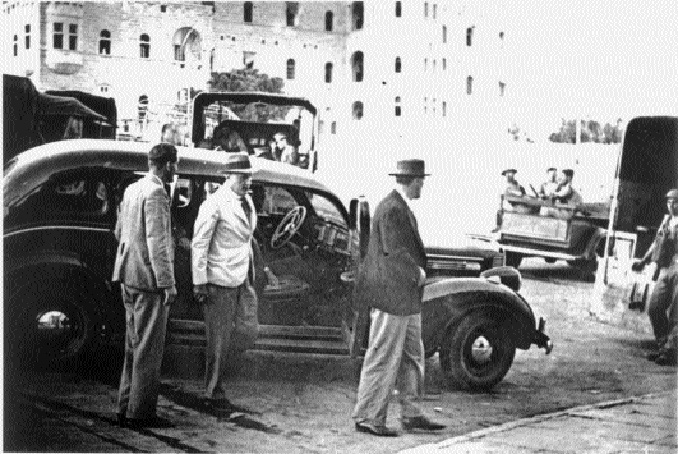
Tegart (centre, emerging from car) in Palestine, c. 1937-8, with Sir William Battershill (right), chief secretary to the government of Palestine. (Bodleian)
In 1924, the Caledonian Society of Calcutta honoured one of the most prominent local servants of the British Raj, Charles Augustus Tegart, the police commissioner of Calcutta. Tegart, later acclaimed as the most famous policeman of British India, was already a hero to the local Anglo-Indian community and a hated villain to Bengali revolutionary nationalists for his intelligence work against their cause. He had survived several assassination attempts, including one at the beginning of the year in which a Calcutta businessman who resembled Tegart was mistakenly shot.
Speakers praised Tegart’s bravery and dedication and singled out one of his qualities in particular: his Irishness. The governor of Bengal, Lord Lytton, joked that attempts to assassinate Tegart were misguided, since he was ‘an Irishman’ who ‘for all we know may be a Sinn Féiner at heart. He is the last man, therefore, to be deficient in sympathy with the cause of Indian nationalism’. Another speaker praised Tegart by saying, ‘I always think an Irishman is specially suited to be a policeman. Being by instinct “agin the government” he knows exactly what people who want to make trouble feel like and is able to forestall their action’. Tegart’s career illustrates the prominent role played by Irishmen in the police and other branches of the colonial service in India. Bengali revolutionaries, meanwhile, imitated the methods of Irish nationalists in their efforts to overturn British rule.
The Irish role in India
Irishmen played a key role in the British conquest and administration of India. The Irish contribution to the making of the British Empire in India took many forms, including viceroys such as the Anglo-Irish aristocrats Lord Mayo and Lord Dufferin. In the late nineteenth century, as much as one quarter of the Indian Civil Service (ICS) was made up of Irishmen, including prominent colonial administrators such as Sir Michael O’Dwyer, the controversial lieutenant governor of the Punjab during the Amritsar massacre of 1919. In addition, Irishmen made up a large part of British military forces in India; in the mid-nineteenth century, as many as forty per cent of the East India Company’s soldiers were Irish. Finally, Irishmen played an important role in the Indian police, a service with neither the prestige of the ICS or the glamour of the Indian army, but one that in the twentieth century was of tremendous importance in the maintenance of British rule in India.
Charles Tegart was a prime example of the Irish contribution to the Indian police. The son of a Church of Ireland minister, Tegart was born in County Derry but spent much of his childhood in Dunboyne, County Meath. He attended Portora Royal School, Enniskillen, and later spent a year at Trinity College, Dublin, before taking the Indian police exam in June 1901. After attending police training college in Bengal, he was put in charge of the police in the city of Patna. In 1906 he was appointed acting deputy commissioner of police in Calcutta, at that time the capital of British India. At this point Tegart became closely involved in the suppression of Bengali revolutionaries dedicated to overthrowing British rule.
Bengal: ‘breeding ground of terrorism’
In the early twentieth century, Bengal, long the centre of British power in India, was at the forefront of the Indian nationalist movement. The 1905 partition of the province, which was viewed as a national insult by Bengalis, led to protests against the government and boycotts of British-manufactured goods. Increasing numbers of Bengalis began to see armed resistance as necessary to secure Indian self-government. Bengali revolutionaries travelled to Paris to learn bomb-making techniques from Russian anarchists, read popular accounts of European revolutionaries, and began planning attacks on British officials. Revolutionary movements were active elsewhere in India, but Bengal was regarded, according to one British official, as ‘the home and breeding ground of terrorism’.
Although the revolutionary movement was limited almost exclusively to the bhadralok, or educated Hindu middle classes, it was considered a potent threat to British rule. From 1906 until 1935, the Bengal police intelligence branch recorded a total of over 500 ‘revolutionary crimes’ in the province. Individual acts of terrorism also created tremendous fear on the part of the Anglo-Indian population. In 1912, a bomb thrown by a Bengali revolutionary, Basanta Kumar Biswas, wounded the viceroy of India, Lord Hardinge, as he was making a ceremonial entrance into New Delhi on an elephant. In the early 1930s, revolutionaries carried out a series of assassinations whose victims included the inspector general of the Bengal police, as well as an attack on the Writer’s Building, the seat of the Bengal government in Calcutta.
As acting deputy commissioner, Tegart carried out many of the investigations of the Bengal revolutionaries. In 1913, Tegart was appointed to the newly-established intelligence branch of the Bengal police, where he helped gather information that led to large-scale detentions and deportations of suspected revolutionaries under the 1915 Defence of India Act. In 1917 Tegart served as one of the principal advisors to the Rowlatt Committee, which was investigating ‘revolutionary crime’ in India.
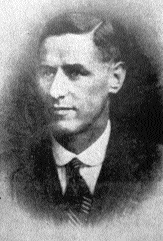
Portrait of Tegart which formerly hung in the office of the Director of the intelligence branch of the Bengal police.
Tegart in Ireland
By this time, Tegart had established his reputation as one of the leading intelligence officers in the British Empire. After the First World War he was stationed in France and England where, according to The Englishman newspaper of Calcutta, he was rumoured to have ‘rendered valuable service in the counter-espionage work against the Bolsheviks’. From July to November 1920, Tegart served as an intelligence officer in Ireland during the Anglo-Irish War, when he was one of several Indian police officers imported to bolster flagging British intelligence networks. He was regarded as an expert on both Irish and Bengali ‘terrorism’. After a 1929 meeting with Tegart, Wedgwood Benn, the secretary of state for India, noted that he had ‘first hand knowledge’ of both ‘the Bengal revolutionary movement… and the Irish revolutionary movement’.
In 1923 Tegart was appointed police commissioner of Calcutta, where he became a hero to the Anglo-Indian community after surviving several attempts on his life. He was knighted in 1926. After his retirement in 1931 he served for six years on the Council of India, the first member of the Indian police to be so honoured. In 1932 he gave a lecture to the Royal Empire Society on ‘terrorism in India’ that was considered the definitive statement on the subject of Indian armed resistance to British rule. In 1937 Tegart was offered the post of inspector general of the Palestine police based on his experience in India. He declined, but accepted a mission to reorganise the police force to combat terrorism there.
Master of disguise
Tegart was thus a truly imperial policeman at a time when Britain was developing an Empire-wide network of intelligence to counter revolutionary nationalist activity. Tegart’s reputation as an intelligence officer was built on what was considered to be an encyclopaedic knowledge of Calcutta. According to the Anglo-Indian newspaper Capital, Tegart possessed ‘an intimate knowledge of the Indian population of the metropolis in all its variations’. Tegart also enjoyed a reputation for using disguise as a tool for intelligence work, in spite of his lack of resemblance to a Bengali. In her unpublished biography, Tegart’s wife Kathleen wrote:
His features were strongly marked, he was tall and muscular, his eyes were dark-blue and his tan had a warm, reddish tinge. Whatever aids might be brought to disguise him he could not appear other than a remarkable Bengali. At night, wearing a beard and puggaree, he could pass as a Sikh taxi-driver, but even in the daytime he could go unnoticed as a Kabuli or Pathan.
Policemen who served with Tegart remembered him using disguise as well. A Eurasian sergeant witnessed him in the disguise of a Bengali gentleman in the Sonagachi red-light district of Calcutta, talking with pimps and prostitutes, accompanied by a number of Indian undercover officers.
Although there are enough stories of Tegart’s prowess as an undercover detective that some are probably true, far more important to his success as an intelligence officer was his ability to inspire the trust of his agents, informers and subordinates. David Petrie, former director of the intelligence, bureau of the government of India and head of MI5, regarded Tegart as one of the best officers at recruiting informants, cross-checking their information, and keeping the confidences of his agents.
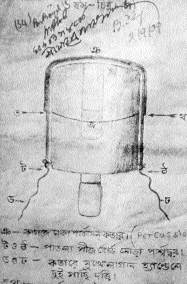
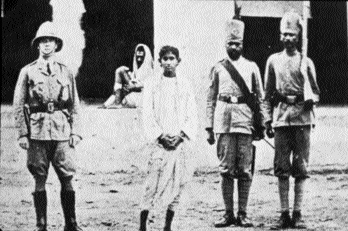
Bengali revolutionary Khudiram Bose under guard. He was executed in 1908 for the murder of two Englishwomen with a homemade bomb, the first assassination carried out by Bengali revolutionaries. His intended target was an unpopular district magistrate.
Indeed, on more than one occasion he was regarded as being too inclined to bottle information rather than risk revealing a source. His wife recalled that the identity of many informers was known only to Tegart himself, who met them ‘always at night, in some lonely place previously agreed on, and rarely took notes but committed the whole of what he was told to memory’.
Reputation for fairness
Even more importantly, Tegart enjoyed a good relationship with his subordinates, the majority of whom were Bengali bhadralok, and thus from the same background as the revolutionaries themselves. According to a number of Bengali officers, he enjoyed a reputation for fairness to his Indian subordinates, and they in turn were fiercely loyal to him. One of the most important of these officers was deputy superintendent Basanta Kumar Chatterjee, whom one officer described as Tegart’s teacher in matters of intelligence work. Chatterjee was targeted for assassination a number of times by the revolutionaries, who feared both his knowledge of their activities and the personal contacts he had with agents within their organisations. In 1915 the government of Bengal arranged to move him to quarters in the European section of south Calcutta, where he would be safer, but the following year he was assassinated while cycling home. Tegart, according to one Bengali officer, ‘wept like an unsophisticated village woman’. Tegart and another special branch officer assumed unofficial charge of Chatterjee’s son, Suren, who himself entered the Indian police in the 1920s and became the first Indian police commissioner of Calcutta in 1947.
Opinions of Tegart differed according to the perspective of the source. According to former ICS officer Percival Griffith, he was a ‘legendary figure’, a model colonial official who inspired the devotion of his Indian subordinates. He was
imperturbable in the face of the danger which beset him for many years…He was one of those men who radiate confidence, and during the worst days of the terrorist movement, the sight of Tegart driving through the streets of Calcutta in an open car with his faithful dog perched on the hood behind him, did more than almost anything else to keep up the morale of those who were fighting the revolutionary movement. Those who worked with him felt that somehow or other he could not fail.
Bengali nationalists, however, drew a far different picture of Tegart and his subordinate officers. The police, seen as a corrupt and oppressive tool of the colonial state, were hated everywhere in India, but nowhere more so than in Bengal, where attempts to suppress the revolutionary movement necessitated an elaborate network of spies and espionage.
Accusations of torture
Tegart was singled out as a hated symbol of the colonial police state in Bengal. At the height of Gandhi’s civil disobedience campaign in 1930, Indian National Congress supporters rejoiced at rumours that he had been assassinated. In addition, rumours of torture and physical abuse of nationalist prisoners committed by Tegart and his fellow officers circulated widely. He was the main figure implicated in the accusations of police torture brought against the Bengal police in 1918 by the Theosophist and Indian nationalist Annie Besant. Besant, an Irishwoman who spent the last forty years of her life in India as an educator and spiritual leader, had been elected to the presidency of the Indian National Congress in 1916. She was a vocal critic of the government of India and launched an Irish-inspired campaign for Indian ‘home rule’. Besant accused Tegart of slapping and punching terrorist suspects and of showing one revolutionary his revolver and threatening to shoot him. Tegart indignantly attributed the accusations to his zeal in suppressing the revolutionary movement. A commission appointed by the government of Bengal concluded—unsurprisingly—that the charges were entirely baseless.
Even fellow officers admitted, however, that Tegart’s police methods were ‘unconventional and dare-devil’ and that he was not above the ‘circumvention of law and procedure to achieve results’. He particularly relished leading raids on the headquarters of revolutionary groups, and it was rare for him not to participate even when he was a senior officer. One of the most famous examples occurred in the wake of the most significant uprising by Bengali revolutionaries, the Chittagong armoury raid in April 1930. When the Calcutta police received information that a number of raiders had taken refuge in the French enclave of Chandernagore to the north of Calcutta, Tegart organised a group of heavily-armed British police officers to capture them. He gained the permission of the French authorities to carry out an illegal attack in the middle of the night, and, after a short gun battle, most of the suspected revolutionaries were captured.
![Cover of Hiranmoy Bhattacharya's, Bharate Biplabbad O Tegart [The Revolutionary Movement in India and Tegart] (Calcutta 1992), a popular book which reproduces Tegart's 1932 lecture, ‘Terrorism in India'.](/wp-content/uploads/2013/02/An-Irishman-is-specially-suited-to-be-a-policeman-5.jpg)
Cover of Hiranmoy Bhattacharya’s, Bharate Biplabbad O Tegart [The Revolutionary Movement in India and Tegart] (Calcutta 1992), a popular book which reproduces Tegart’s 1932 lecture, ‘Terrorism in India’.
![‘Our frightfully efficient police'-Tegart, bristling with arms, is depicted arresting a schoolboy with a document reading ‘hartal' [general strike]. (Dainik Basumati, 21 February 1928)](/wp-content/uploads/2013/02/An-Irishman-is-specially-suited-to-be-a-policeman-6.jpg)
‘Our frightfully efficient police’-Tegart, bristling with arms, is depicted arresting a schoolboy with a document reading ‘hartal’ [general strike]. (Dainik Basumati, 21 February 1928)
Ireland a model for revolution
Bengalis may have hoped that Tegart’s ‘wild Irish’ nature meant he had a special sympathy for Indian nationalism. During his tenure as police commissioner, one of the most prominent models for revolutionary activity was the actions of Irish republicans during both the Easter Rising and the Anglo-Irish War. In February 1926, the Daily Mail reported that ‘Ireland has furnished the inspiration for the revolutionary movement in Bengal. Nothing interests the Bengali so much as the story of the rising against Dublin Castle, with its attendant ambuscades, assassinations, and street fighting.’ Young Bengalis were urged to read the story of Patrick Pearse, described in a 1929 revolutionary leaflet as ‘the gem of young Ireland’, whose death ‘roused in the heart of the nation an indomitable desire for armed revolution’. In 1930 a group of revolutionaries even sought to stage their own ‘Easter rising’ in the eastern Bengal town of Chittagong. On the night of 18 April, Easter Monday, a group of over sixty revolutionaries armed with revolvers and pistols captured and set fire to police armouries there. The inspiration of Irish precedents was clear in the leaflets distributed afterwards by the ‘Indian Republican Army, Chittagong branch’.
One of the most common sources used by Bengali revolutionaries was Dan Breen’s My Fight for Irish Freedom (1924). Breen’s book was banned by the government of India in 1929; nonetheless it circulated widely and was translated into Hindi, Tamil and Punjabi. The district magistrate of Chittagong described My Fight for Irish Freedom as ‘a textbook for the revolutionaries of India’ and argued that ‘the action of the revolutionaries was largely inspired by this book and…their plan of action was based on its lessons’. In 1930 the government of Bengal asked for Tegart’s advice on measures to restrict further the circulation of Breen’s book. The government of India had previously prohibited its import, but copies already in circulation could not be seized.
Tegart’s response suggested that, in his opinion, Breen did not tell Bengali revolutionaries anything they did not already know about recent Irish history. ‘An interesting book founded on facts which are now history’ was his verdict. Tegart argued that it would be a mistake to proscribe the book in Bengal. Copies found in Calcutta were already being seized by the police, whether they had been imported before or after the ban. ‘To proscribe the book at this stage’, he wrote, ‘would attract fresh attention to it and would, as far as the Calcutta police is concerned, not give us any power which we have not got already.’
In spite of comments by English observers that his ‘Irishness’ gave him a natural understanding of Bengali nationalism, Tegart had little sympathy for Bengali revolutionaries. Perhaps because of his experience in Ireland, and almost certainly because of the constant threats on his own life and the murders of his Bengali officers, Tegart viewed Bengali terrorism as cowardly and evil, and gave less credence to nationalistic sentiment than did other intelligence officers.
Tegart drew on widely-held British racial assumptions about Bengalis in formulating his opinion. Terrorism, he argued, arose from the dysfunctional dynamics of Bengali society and was based on ‘perverted religion and equally perverted patriotism’. The physique of the Bengali, a ‘non-martial race’, was ‘inferior’, and such ‘intensely sensitive and emotional beings’ were easily manipulated by terrorist leaders. Tegart mocked the idea of Bengalis imitating the actions of Irish revolutionaries. While interrogating revolutionary prisoners imprisoned in the Andaman Islands in 1913, Tegart reported how one revolutionary was known among the prison staff as ‘All for Ireland’ for his attempts to enlist an Irish jailor’s sympathy ‘as another oppressed subject of the British Crown’, saying, “We fought for the Irish also, we are all for Ireland”’.
An element of Irish patriotism
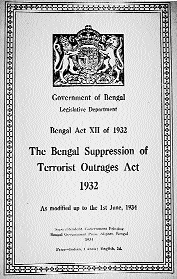
Throughout a lifetime of service to the British Empire, Charles Tegart maintained connections with Ireland and Anglo-Irish institutions. He became president of the Old Portora Union and attended their annual dinner in Dublin, along with that of the Trinity College Dining Club. In 1933 Tegart, together with Douglas Hyde, was awarded an honorary LLD at Trinity College, an honour which, according to his wife, ‘gave him as much pleasure as any he had hitherto been awarded’. Tegart combined an element of Irish patriotism with the conviction that a ‘friendly union’ between Ireland and the British Empire was the best course for Ireland. During World War II, he served in the Ministry of Supply in Britain and in 1942 took charge of the Ministry’s anti-black marketeering campaign. Tegart was frustrated by Ireland’s neutrality. According to former Indian police colleague J.C. Curry, Ireland’s refusal to enter the war on the side of the Allies was a ‘lasting and bitter disappointment to him’.
Tegart, like other Irish imperial servants, combined an Irish identity with a lifetime of service to the British Empire. While British colleagues joked about Tegart’s latent sympathies with Indian nationalism, what he displayed most prominently was a fierce loyalty to the British crown, and an animosity towards those—Irish or Indian—who sought to break ties with the British Empire. Kathleen Tegart contended that while Tegart detested partition and ‘was anything but an Orangeman’, he also ‘firmly believed that friendship and co-operation with the British Empire was Ireland’s only right policy’ and combined, in the way that only a Southern Irishman can, a deep and unquestioning loyalty to the Crown and Empire with an almost aggressive love for his own country’.
Michael Silvestri is a Visiting Assistant Professor at Clemson University, South Carolina.
Further reading:
J.C. Curry, Tegart of the Indian Police (Tunbridge Wells 1960).
S.B. Cook, ‘The Irish Raj: social origins and careers of Irishmen in the Indian civil service, 1855-1914’, Journal of Social History 20:3 (Spring 1987).
T.G Fraser, ‘Ireland and India’, in K. Jeffery (ed.), ‘An Irish Empire’?: aspects of Ireland and the British Empire (Manchester 1996).
N. Kapur, The Irish Raj: illustrated stories about the Irish in India and Indians in Ireland (Antrim 1997).
















